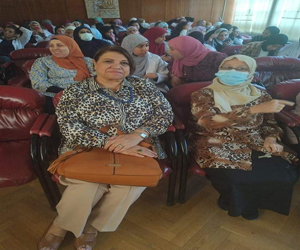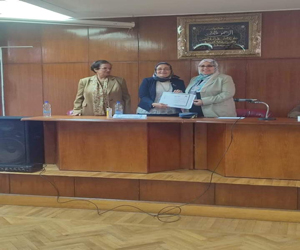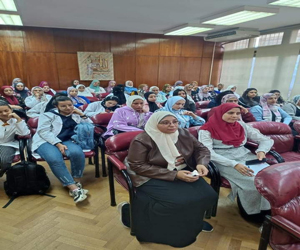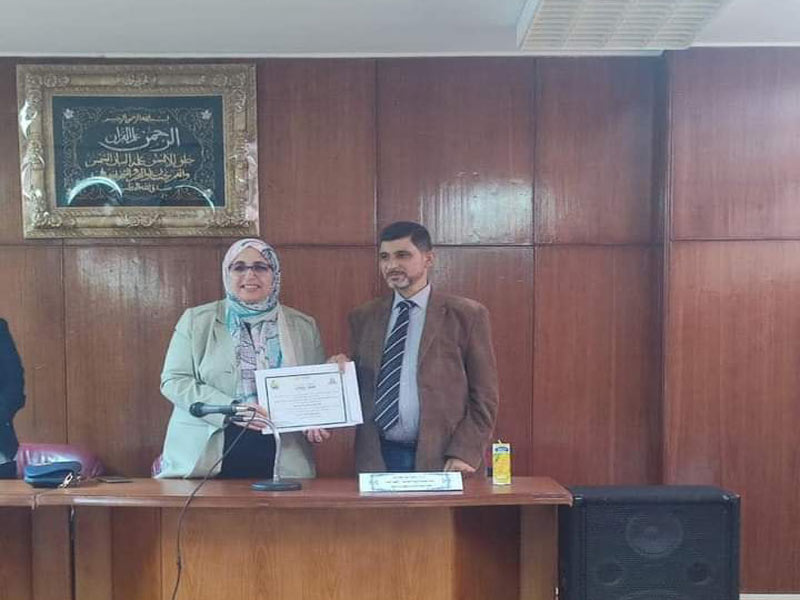Symposium on the impact of climate change on the environmental system in the Faculty of Girls
In light of the interest of the world and the Egyptian state, especially in climate changes and the importance of preserving the environment, the Community Service and Environmental Development Sector at the Girls' Faculty held a symposium entitled The Impact of Climate Changes on the Environmental System, and this came under the auspices of Prof. Dr. Mahmoud El-Meteini, President of the University and Prof. Dr. Ghada Farouk, Acting as Vice President for Community Service and Environmental Development, Prof. Dr. Amira Youssef, Dean of the Faculty and Prof. Dr. Heba Barakat, Vice Dean for Community Service and Environmental Development, in cooperation with the Botany Department of the Faculty
The symposium included the following:
1- Mangroves and blue carbon and their role in limiting climate change
It was presented by Prof. Dr. Nahed Mohamed Nour El-Din, Professor of Physiology of the Plant Environment and former Head of the Department of Plant Environment and Pastures - Desert Research Center.
The mangrove plant can absorb greenhouse gases such as carbon dioxide by 4 times the tropical forests and it is called blue carbon because of the spread of this plant on the sea coast, and studies confirm the decrease in the proportion of heat emissions in Malaysia in general by 1% as a result of the expansion of mangrove forest cultivation, and this means that Preserving and restoring mangroves is essential to combating climate change, the warming of the global climate caused by increased carbon emissions, which is already having catastrophic effects on communities around the world, as well as being an important means of protecting beaches, as it acts as a defensive barrier during operations. The tides in the sea, and thus protect the coasts of the Red Sea from the operations of slaughter.
 |
 |
 |
||
There are two types of mangroves in Egypt, the first is called Shura or mangroves and its scientific name is "Avicinia Marina", which is widespread on the Red Sea coast, while the second type is "Al-Qandal" and its scientific name is "Rhizophora macronata" and it is widely spread in Egypt. This plant is considered a treasure because it grows in saline waters such as the waters of the Red Sea, which has a salinity of about 40 percent. It is expected that this plant will have a future role in transmitting genes through which field crops can tolerate salinity.
Given the importance of the mangrove plant, since 2017, Egypt has rehabilitated the areas in which the mangrove plant grows naturally, as well as planting new areas with this plant.
The total areas of mangroves that grow naturally on the Red Sea coast, in the Gulf of Aqaba and the Ras Muhammad Reserve in South Sinai are estimated at 1,150 acres. Cultivation of 600 acres of new mangrove plants.
1- Plant diversity and climate change
It was presented by Dr. Ahmed Ahmed Khalaf Allah, Assistant Professor of Plant Ecology - Department of Botany - Girls College of Arts, Sciences and Education.
Climate changes are greatly reflected in various aspects of life, which have become significantly noticeable in recent years.
Climate changes are represented in the rise in the earth's temperature, the melting of snow in the North and South poles, in addition to the occurrence of flooding with sea and ocean waters, which greatly affects all living creatures.
Over the past 100 years, trends in plant biodiversity loss have been a major concern, and despite all the efforts made to preserve plant diversity, the situation remains alarming as climate change greatly affects plant diversity, as many species, especially those with Rarely, to be affected by climate changes, which could expose them to extinction as a result of these changes.
As a result of the negative effects of climate change, we find that there are 45 endemic plants in Egypt - that is, they are not found in any part of the world except Egypt - and only 11 species have been listed as globally threatened species on the IUCN Red List, foremost of which are the "mountain mustache" and "" Wild roses, which are endemic to the high mountains within the borders of Saint Catherine Reserve, have been listed as critically endangered species, as these plants are exposed to destruction and continuous and rapid deterioration as a result of climate change and drought.
Some measures necessary to preserve biodiversity:
1- Developing laws and declarations through which the state declares that a specific area is a natural reserve that must not be approached or violated in any way.
2- Establishing and establishing banks to preserve and collect the genetic material of all endangered plants.
3- Reducing all forms of human-caused pollution.
4- Reducing the cutting of trees, and setting financial fines and penalties for those who do so.
5- Avoid overgrazing, which threatens wild plants, especially endangered species.


.svg)




